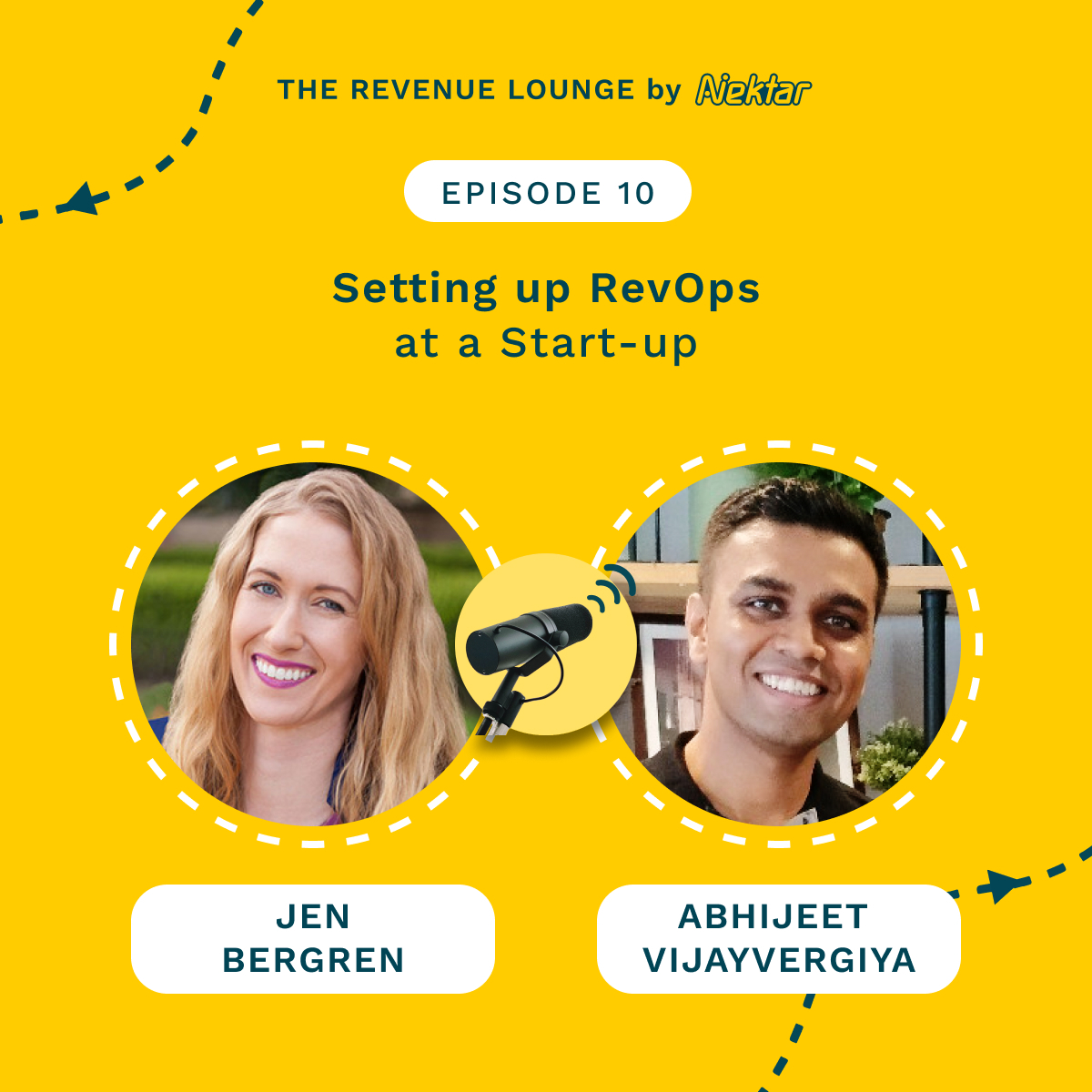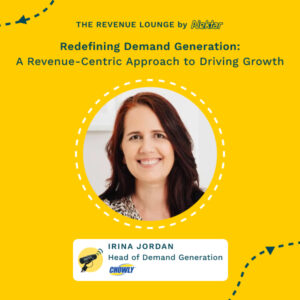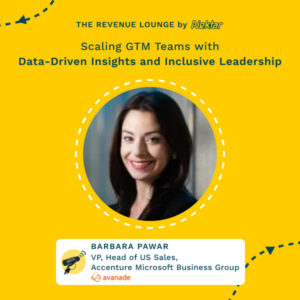Improving Customer Experience by Knowing your Data ft. Steffen Hedebrandt
April 3, 2024
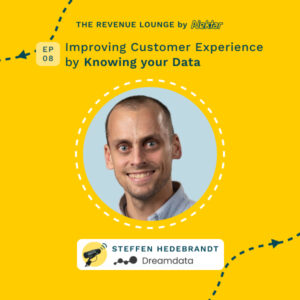
About
The Revenue Lounge
The podcast covers stories from leaders across RevOps, Sales, Customer Success, GTM, Data and Marketing about what drives these functions and what advice they would share with our listeners. With 3 seasons recorded, the podcast currently features 50+ enterprise leaders in the B2B SaaS domain. Tune in to hear from the best in the business
Data is the lifeblood of any successful B2B marketing strategy. It’s not just about collecting information; it’s about knowing how to extract actionable insights from it and, most importantly, how to use those insights to improve the overall customer experience.
This episode explores how to harness the power of data to better understand your customers, anticipate their needs, and ultimately, create a more meaningful and engaging customer experience. And joining us today is Steffen Hedebrandt. Steffen is the Chief Marketing Officer & Co-Founder of Dreamdata.
He is data-driven revenue leader and has a successful track record of scaling businesses and building teams at Upwork and Airtame. Let’s hear it from Steffen!
Want to learn more about Nektar?
Talk to our team – https://bit.ly/3MishjZ

[00:00:26] Data is the lifeblood of any successful B2B marketing strategy. It’s not just about collecting information. It’s about knowing how to extract actionable insights from it. And most importantly, how to use those insights to improve the overall customer experience. In today’s episode, we will explore how to harness the power of data to better understand your customers, anticipate their needs, and ultimately create a more meaningful and engaging customer experience.
[00:00:52] Hello everyone. Welcome to the Revenue Lounge podcast. I am your host, Randy Likas. And joining me today is Steffan Hedebrandt. Steffan is the chief marketing officer and Cofounder of DreamData. He is a data driven revenue leader and has a successful track record of scaling businesses and building teams at Upwork and Airtame.
[00:01:09] Hi, Steffan. Thank you so much for joining us today.
Thank you so much, Randy. I’m happy to be here. And I think this is a topic that we’re going to talk about that is. On the heart of both you and I.
That’s absolutely correct. Yep. So before we get into the meat of it, I would love to hear a little bit more about you, what’s your role at DreamData and as co founder of DreamData, tell me how this was born.
[00:01:29] Yeah, as you said, I’m a co founder and I’m probably perhaps even more than, than I’m a CMO because when you’re a co founder, sometimes you need to pick up tasks that no one else is dealing with. So sometimes I’m spending a Too little time on marketing, but marketing is a B2B marketing in particular is my passion and my trade.
[00:01:50] So that’s my background. The way I got into this whole thing was like kind of a, somewhat out of pure pain because I really believe you should be doing marketing to impact the [00:02:00] company’s sales pipeline and revenue. But when you’re in B2B, it’s not that simple because all the major ad platforms out there don’t really have any good tools for actually explaining you how the money you invest today becomes revenue six or 12 months later.
[00:02:16] And yeah, once I met my two co founders that had actually been going at this problem at another company where they came up with an ugly, but working prototype, then I thought, okay. If we together can, can do a good swing at this. I know there’s a big market of B2B marketers out there struggling with this.
[00:02:34] So what is the core. value proposition that DreamJade is helping the organization solve. So we help our customers understand how they get new customers. So that means we understand any digital reflection that have been recorded anywhere, and then that enables you to invest more where you see revenue coming from.
[00:02:54] And for us, that’s particularly from marketing activities. And we also help them stop running all [00:03:00] those, not to bash too much, but like things that they call brand campaigns where there’s no connection to revenue at all. Uh, so in general, it’s about helping B2B marketers invest money more efficiently. I think there’s some correlations or like overlaps with what Nectar does, but it seems like you’re also obsessed about helping companies produce more money as well.
[00:03:21] Absolutely. Everything right now is A. I. and our belief is that. The best AI applications out there are only as good as the data that they’re running on top of. Companies need to really understand and figure out their data issues, but if they ever want to see the promise of the AI applications in the context of knowing your data and really getting to understand your data, what recommendations would you make in terms of how companies would go about doing that to improve customer experiences?
[00:03:46] In other words, how does an organization really understand their data? To improve revenue, improve customer experiences. Yes. So like here I have to label that I only understand or have worked with B2B [00:04:00] customer journeys and like the go to market part of it, meaning from before you hear about us until you’ve bought your board or signed a deal with us.
[00:04:07] In that part, what is secure? Grossly underestimated is the fact that in B2B, you’re selling to teams and the customer journey is long, but all the typical tools that marketers out there rely on, they’re built to understand the behavior of individuals, which means that marketing quite often ends up looking like a cost because they will invest money and they will start a lot of journeys.
[00:04:31] But because 12 months from the interaction with your marketing content to. The sales outcome marketing gets detached from it. And then it starts looking like a cost center instead of what it actually could be, and in fact is for a lot of companies, it’s a revenue driver. So there’s a lot of flaws in the ad platforms, not being able to understand the B2B context.
[00:04:56] Google Analytics have no clue at all. The CRM [00:05:00] systems is, I’m sorry to say, not a good source of truth when it comes to understanding customer journeys either, because CRMs, they will just capture the last session in which a form is submitted. But the truth is that nowadays, People spend more than 50 percent of their time in their customer journey, just researching stuff anonymously.
[00:05:20] For example, when we have a demo called booked on our website, there’s an average of five demos, five sessions in that demo call the last session. It’s always direct because now they’ve researched you, they trust you, and they’re about ready to talk to you. But the first session of this, that individual will, will be from some kind of.
[00:05:39] A BDR or a marketing activity that initiated the contact. And then the next visit would be maybe organic search from Google, where they put type in the brand. And then the last couple of sessions, it start typing in your brand in the browser and it suggests the browse. And then you click enter and the CRM system will say, [00:06:00] Hey, this journey started by somebody coming in directly.
[00:06:04] But that’s not true. Demand doesn’t come out of nowhere. So where I think that the biggest flaw is that Until recently, we dreamed that there was not a lot of tools out there that can actually truly help marketers understand how, what they do impact sales and revenue. So Stefan, a lot of what we were talking about is understanding the anonymous activity that goes on as companies are starting to think about working with you.
[00:06:28] And that it’s not about a form fill. It’s not about when an SDR reaches out to them, but all the work they’ve done before that. A lot of that sounds like it’s a little bit out of the control. Of the marketer to really understand that. So how do you think organizations could take more control of their data or get a better understanding of some of the searching that’s going on?
[00:06:45] Yeah. I think like step one is to picture your, your average customer journey. What are the things that takes place there? Are you actually generating digital touches throughout the customer journey? So it’s your sales team just sitting with their own [00:07:00] phone, like cowboys, just calling. All sorts of random phone numbers or are they using a, uh, piece of calling software where they register at on this day, we call this account, we reach this person, et cetera.
[00:07:12] The same thing for the CS team. Are they just sitting in like a Gmail inbox or do they use a piece of software that helps them keep track of what’s going on? The same thing for tracking their website. Are they relying on some third party entity? Like what A lot of. Customers that comes to us realize is that they’ve been relying on third party resources for tracking their whole digital presence for a long time without actually owning the data that is being recorded and being recorded mean that it actually lands.
[00:07:46] In a data warehouse where you sit on top of this data and it’s yours and you have collected it first party, whereas it’s not been necessary before all these privacy things that you actually need to own your own data and control that. So I think [00:08:00] like thinking through kind of what does our customer journey look like out of all the activities that we do are most activities actually leaving behind a digital trace or not.
[00:08:10] If not, that’s where you start. You start forcing your sales team to use a calling software. You start tracking first party. So you own the data once. So once you want to analyze it, you actually have it available. Then you probably know this better than me, Randy, as well, but like CRM discipline, actually making sure that the reps register stuff.
[00:08:32] This user belongs to this account. So when you want to unfold the story, there’s actually a track record of what took place when they ship an email, they Salesforce or Hotspot or whatever you’re using. Yeah. The technology is out there now. That you shouldn’t even have to ask your reps to do that. Right.
[00:08:52] That’s a mundane, repetitive task. Like we can automate that, keep them focused on the high value activities. It’s actually going to drive revenue. The [00:09:00] technology has come a long way to enable that. And as you talked about before, like making sure that you’ve got the right technology in the hands of the right people to collect this information.
[00:09:08] But that sometimes can create a hurdle, right? There’s adoption hurdles. There’s other hurdles that may be along the buyer journey, the customer journey. If it’s not invisible to them, it’s just an extra step. So how do organizations. deal with those hurdles and how can they remove those hurdles to improve capturing the buyer experience.
[00:09:24] I think there will be a little bit of repetition of what I said before. It’s really like weeding through kind of all your activities and making sure that you leave behind digital touches of what you’re doing so that. Once you get the need to analyze what’s going on, you have actually been producing data proof or like evidence, because it’s a bit like that kind of Chinese proverb of what’s the best time to plant a tree.
[00:09:49] And the best time was 20 years ago. Yeah, right. And the second best is today. And that is a little bit with like data and analytics is that you can’t start today [00:10:00] when your customer journey is six or 12 months long, you need to start now. So whenever you feel like actually digging deeper, your company have actually been generating data for a meaningful period until this point.
[00:10:13] Let’s talk about data hygiene for a moment. If we were to plan today and say, moving forward, we’re going to put these new technologies in place and we’re going to capture the right data, but we’ve probably got a lot of data that we already have that isn’t at the best quality. How do companies dealing with data hygiene issues or how’s DreamData helping solve some of the data quality issues?
[00:10:30] So we don’t, Push data into serum systems to change what’s in their serum system. But we extract the data out of the different tools that touch the customer journeys amongst the serum. And once we get the data out of the systems, it can become sometimes quite clear for us if you have a lot of duplicate accounts, and then we can tell our customers, Hey, it looks like this might be an issue for you.
[00:10:54] You might probably want to go and resolute some of them to the same account. And it’s a lot of [00:11:00] hygiene things like. The UTMs that you set or not set on all the things you’re doing, going to market on your ads, in your invites to events, in the emails that you sent, if you haven’t set up UTMs, you’re driving a car very blindfolded or.
[00:11:16] If you have had a really sloppy, what do you call it? Hierarchy of how you name things, then it can be very hard to understand what’s going on. I think getting your data in a good place to say, to be that kind of annoying person that follows best practice quite often. So good, clean hierarchy of UGMs, making sure that the sales reps are keeping a good hygiene in the CRM and.
[00:11:39] Naming of the newsletters is, is I think it, it gets, I guess it’s kind of a commitment to be data driven and it means that anybody in any position do what they can to help your company having a clear set of data that you can look at from at least your seat. So let’s assume we’ve got our systems in place.
[00:11:58] We’re now collecting [00:12:00] good data. We feel that we’ve got a lot of data. But data is only as good as the insights that we can translate out of those. Right. So what recommendations do you have for companies to take that data and actually turn them into actionable insights? Yeah, I think the way I use our own product and other pieces of data is that I look for outliers, like what clearly looks like a bad investment of time and money, or what clearly looks like a good investment.
[00:12:25] That’s kind of, you want those. I want to run with the clear signals and don’t spend too much time on that big gray middle. So say you ran a big campaign, no leads came out of it, stop doing that. Or like clearly the lead ads that we’re running here converts a lot of accounts that looks like those we normally sell.
[00:12:46] So let’s put money in there. I think over time you also develop a gut feeling of, you know, in business, we’re not Doing science, but we need to see some metrics that connects with our gut feeling about [00:13:00] this being meaningful and then you can start to double or triple your investment, whether that’s a BDR team that does outbound or an email campaign you’re running or whatever it is.
[00:13:09] Yeah. In business, we’re looking for signs of traction that, that we believe is enough to combine with our gut feeling and then hit the gas. What are some of those metrics that you find companies should be paying attention to or to make sure that what they’re doing as far as the collection of data is actually driving the outcomes they want?
[00:13:26] So I view the world through a marketing lens and typically what most marketers struggle with it is to move from what they’ve been used to the last 10, 20 years, like delivering amount of emails that they can collect per month, shifting that towards a more meaningful outcome for your business. So whether that’s produced sales pipeline or sourced revenue, as far down the funnel you can go, the better.
[00:13:51] And the customers we have that start making that shift from just generating leads to actually taking accountability for producing [00:14:00] sales pipeline. They, like a customer I spoke to a few months back said that they improved their lead to sales opportunity rate with 41 percent by starting to invest their time and money into things.
[00:14:14] Where they had, let’s call it revenue proof rather than just collecting more email addresses for the business. I want to go back to something we talked about earlier, which is this idea that following a single person who maybe did a form fill on the website or downloaded a white paper, um, is okay. Right.
[00:14:31] But what’s probably more valuable is understanding when buying committees start to get activated. Right. So it’s three, four or five different people start going to your website. And I read a Forrester article that too long ago, and they kind of asked the paradox question, which is what’s more valuable.
[00:14:45] The one person that downloads four white papers in a week, or four people that come to your website, maybe don’t download any white papers, but are visiting your website and checking out pages. So what we’re finding is that buying committees and multiple people on the account is probably a really good signal.
[00:14:59] [00:15:00] Starting to enter into some kind of a purchasing decision. We’d love to just get your thoughts in terms of buying committees in general and how companies should think about activating the buying committee. I think that’s a really good, I’ll take those four or five people on the website anytime. And it’s a typical pattern we see as well.
[00:15:17] Like at dream that we do these kinds of customer journey maps where you can see touches on different people and. It was typically start with like a single string. And then once things start heating up, you see four or five, six, seven people getting involved in the deal. I think most B2B companies really underestimate, uh, the fact that you’re selling to a buying committee.
[00:15:40] You create all your content to like address that pain point of that one champion that shows up. And then you forget that actually that one champion, he needs to go back to his company and sell whatever idea you’ve sold to him or her. So I think about it that way, that just because we do a one good demo to [00:16:00] one person doesn’t mean we get the deal.
[00:16:02] There’s still a lot of work left after that one successful demo. And that’s where you need to understand how is the dynamics of. This company that we’re trying to sell to, is it the CFO that gets involved? Is it the security officers, the legal counsel? Is it the CMO or what is the landscape that our champion is going to face?
[00:16:22] And once he comes back and says, I want this product and you need to. Do you know the game of curling where they like, they wipe the ice and the stone runs. It’s a little bit like that. You should be thinking like, how can we enable the one champion that likes us to go back to his company and answer all these questions that he’s going to be asked about security, about business case, ROI, whatever he’s going to be asked.
[00:16:49] You need to help him, whether that is through content or like. Talking with about how do you answer the FAQs that I’m sure that they’re going to be throwing at you afterwards. Yep. [00:17:00] A hundred percent. I love that analogy of the curling. I’m going to steal that from you if you don’t mind. I, you know, I, what we see often when we’re dealing with our customers is as a buying cycle starts to unfold and people are being brought into copying emails and brought into meetings and so on and so forth.
[00:17:15] There’s a gap right now in a lot of technology in terms of being able to capture those members. And especially. tying them back to the CRM record, right? Because most reps, they create an opportunity. They have one person on the opportunity and they never go back and update it. And so at the end of the sale, there’s probably 10 or 15 people that touched this opportunity.
[00:17:32] But when you look at the CRM record, there’s one, maybe two people that are attached to it. And that’s a big disconnect for loggerizations. And that’s probably what we’re trying to help our clients solve for. 30 minutes about buying communities alone. It’s really something that I get excited about. But what I’d like to do is maybe just transition a little bit into a different bit of a format, which are rapid fire questions.
[00:17:51] I’d love to hear about the one book that you have read in the recent past that you’ve really loved. I’m going to go with a classic called the art of war, which have you [00:18:00] familiar with it? I am being referenced in a million American movies as well. But I thought about, okay, let me try and read it. And it is like this Two, 3000 year old Chinese book about war.
[00:18:11] But the advice is about when to engage in a war, when not to, how to prepare, et cetera, that’s really sound business advice still, like the war is over before it begins, that’s your sales tax, that’s your prep for a call, that’s the positioning you do within the meeting, et cetera. So I would say the art of war by Sun Tzu.
[00:18:31] If you feel like needing some, even life advice in general, but business advice, then. It’s pretty fastly read, but there’s a lot of solid tips in there. Yeah. I read it a while ago, quite frankly, but I took to have the same takeaways that you did as well. It’s one of those things I think that maybe every five years, somebody should pick up and read again because of all the lessons that are in there.
[00:18:52] Absolutely. So what’s your favorite part about being a marketer? What really gets you out of bed and gets you excited? So I think I really liked the massive impact [00:19:00] you can have on a business. If you do it well, I’m a practitioner of digital marketing in particular. So like the fact that I can just sit behind my computer and do stuff that attracts people from all over the world.
[00:19:14] And then keep the whole sales team busy from those activities. I think the potential that there is to do marketing today is absolutely astonishing and it’s so cool to be able to grab a few of those bites. Yeah. What about the other side of that coin? What’s your least favorite part about being a marketer?
[00:19:31] Or maybe ask a different way. What’s hard about being a marketer right now? It’s such a, Broad discipline today that it requires insane amounts of skills and everything from field marketing to crunching numbers, to data, to a website, positioning, category, like sometimes you can feel like you’re being pulled down through the middle because you need so many different skills to be really great at this [00:20:00] discipline.
[00:20:01] I think it comes with experience. You get to know yourself and understand, okay, which of these disciplines am I actually good at? And what should I say no to? Because there’s no passion. There’s no desire to get better at that. I’d say at least it gotten better for me as I get a little bit more experience that.
[00:20:17] I know that there’s stuff that I’m good at that should probably get some other people to jump on. Yeah. But the demands, have you seen CMO job posts lately? It’s just like an ever long list of requirements for what you need to be able to do, and I think that’s, Until you realize who you are and what your skills are, that can be very confusing as a marketer.
[00:20:37] Yeah. And just the rapid amount of change that’s going on as well. Like what do you invest in as far as broadening your skill set, but also that’s not my space. That’s not my lane. That’s better suited for someone else. Yes, absolutely. Any advice that you’ve received from someone that’s really stayed with you that maybe you’d like to share with us?
[00:20:53] I think if we stay in the same kind of lane, then stay with what you’re good at, and then [00:21:00] don’t take too many well meant advices of other things you should try doing, if there’s one thing you’re really good at. Double down, triple down. And then for example, in the beginning, we got a lot of advice on, Hey, you should do outbound.
[00:21:12] And none of us founders had experience in doing outbound, but we tried it and we wasted six months doing it. And then I switched to doing B2B marketing instead. Then the growth like exploded because that’s my skill. So listen to people’s advice, but don’t just adjust your cost just because somebody says that could be cool or that worked for them.
[00:21:33] Yeah, it’s okay to, I think, experiment, but if you’re going to try something new, if you’re going to fail fast, right? And don’t spend too much time and resources going down a lane that you don’t understand. Exactly. Yeah. What about someone who maybe would like to have your job someday? They’re in marketing, they’re maybe a couple of years out of their career, but they aspire to be a CMO.
[00:21:52] What, what advice might you give them? Focus on stuff that impacts your company’s revenue or [00:22:00] bottom line. When the hard times comes, that’s the only things that, that matters. So if you want to really be successful in your career, then be like hardcore on producing tangible value for the company you, you work at.
[00:22:15] And then it’s both a marathon and a sprint, but it’s more a marathon. So you need to keep showing up every day and do 1 percent better every month, 2 percent better every month, because the momentum will peak will pick up at some point, but it takes you being consistent and keep showing up. That’s probably from your experience as well, Randy, that do that extra call with a client or send that extra mail.
[00:22:38] Because. These small things compound at the end and then people will see your results. Yeah, it’s great advice. It actually reminds me of a piece of advice that I had received, which was. win the day, because if you can win the day, you’re going to win the week. And if win the week, you’re going to win the month.
[00:22:58] If you can win the month, you’re going to win the year. So [00:23:00] you got to your point of being 1 percent better every single day, just focus on what’s in front of you and what you can control now. And the rest will take care of itself. Forget about that kind of unicorn Facebook like growth, which is so rare and unattainable for most, which takes incredible like luck and momentum.
[00:23:18] And just think about Can I just do it a little bit better today than what I did yesterday? Then that will take you to a good direction. Yeah, a hundred percent. Love it. Well, Stephen, that’s a wrap for today. I want to thank you again for joining us on the revenue lounge. I really enjoyed our conversation and I look forward to continuing our relationship offline.
[00:23:35] Thank you, Randy.

Ep #1: Navigating the Downturn with a Hyperfocus on Productivity
Listen Now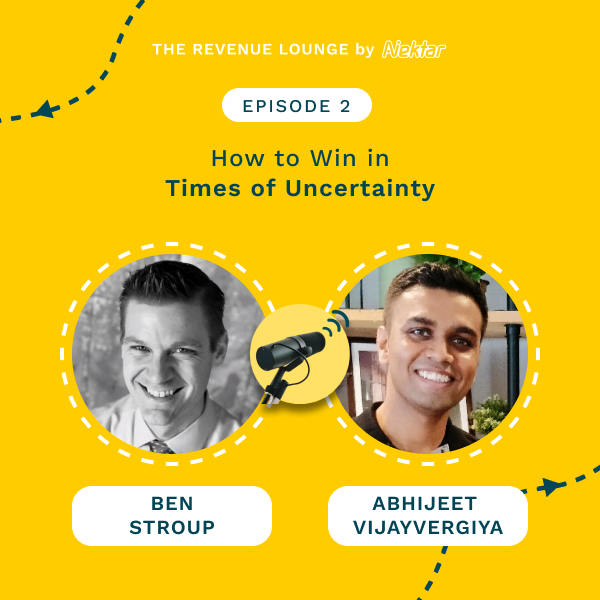
Ep #2: How to Win in Times of Uncertainty
Listen Now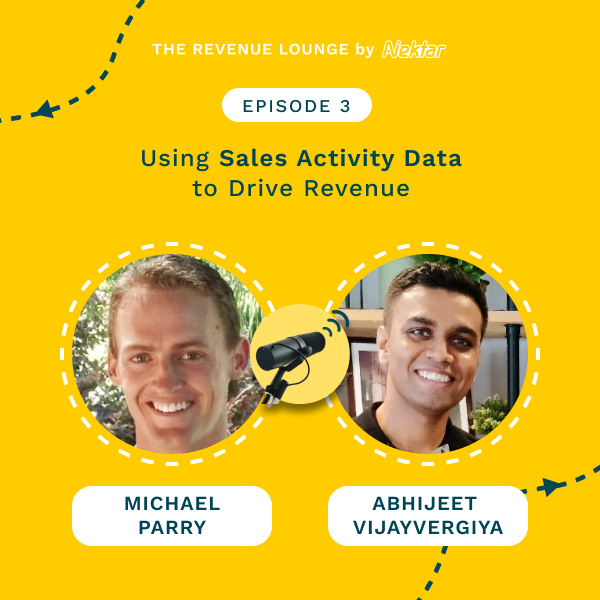
Ep #3: Using Activity Data to Drive Sales Productivity
Listen Now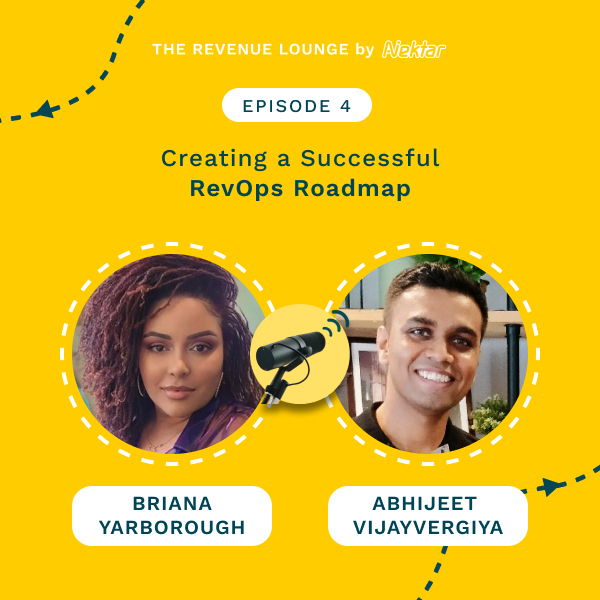
Ep #4: Creating a Successful RevOps Roadmap
Listen Now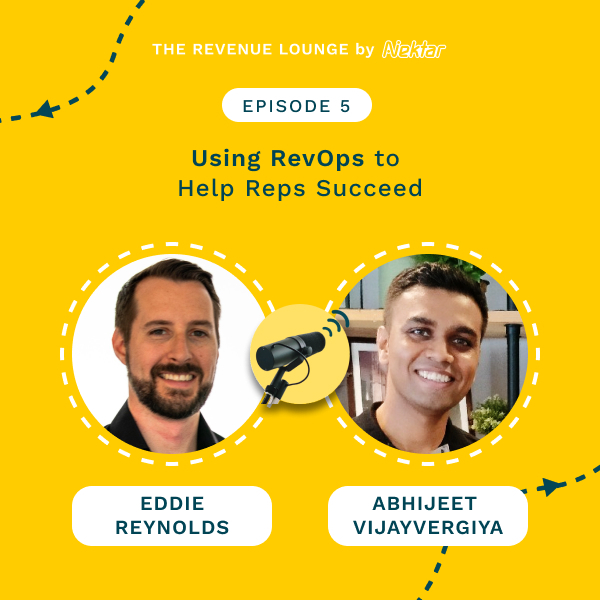
Ep #5: Using RevOps to Help Reps Succeed
Listen Now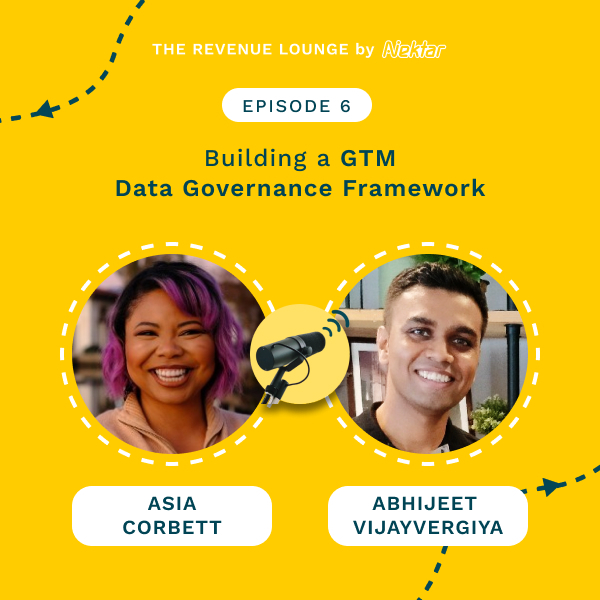
Ep #6: Building a GTM Data Governance Framework
Listen Now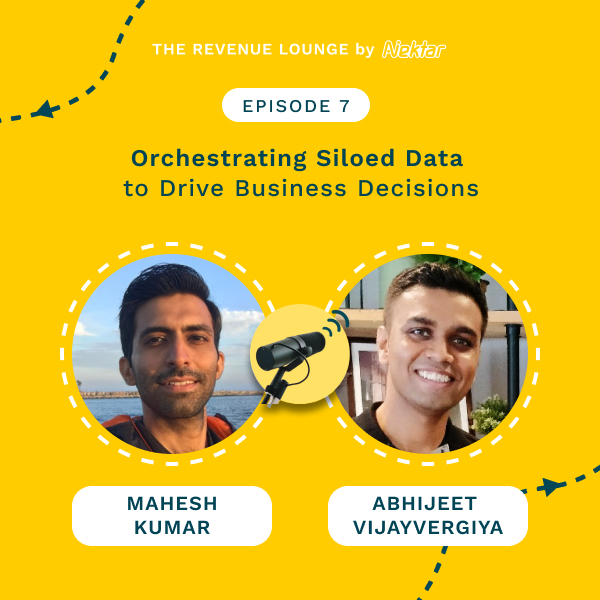
Ep #7: Orchestrating Siloed Data to Drive Business Decisions
Listen Now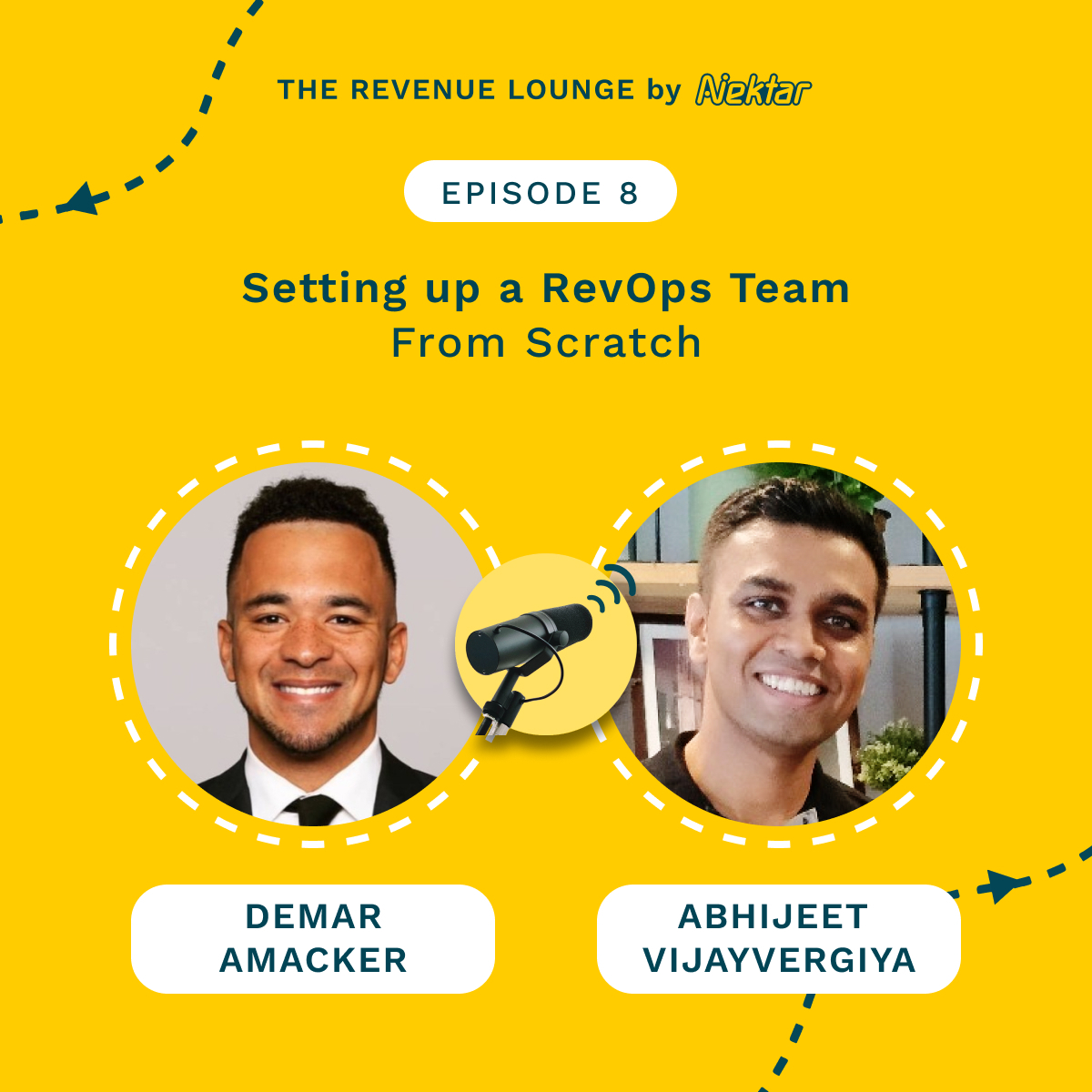
Ep #8: Setting Up a RevOps Team From Scratch
Listen Now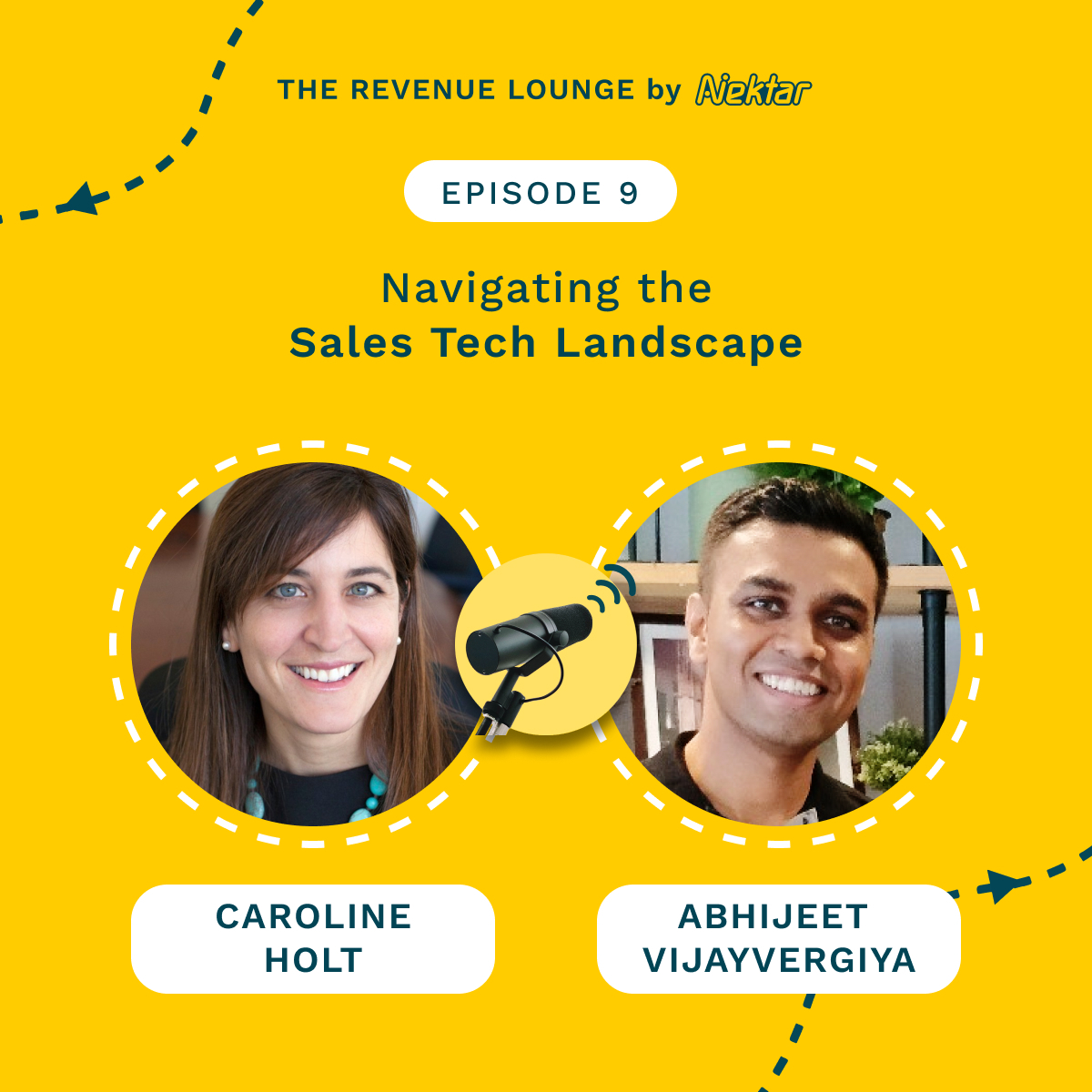
Ep #9: Navigating the Sales Tech Landscape
Listen Now